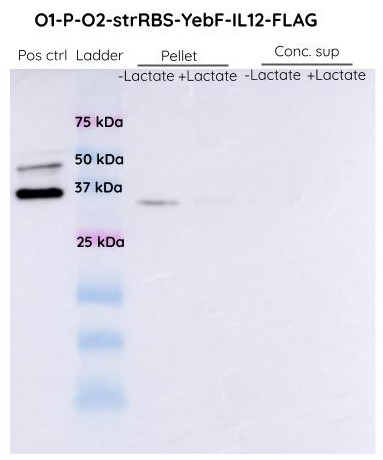Difference between revisions of "Part:BBa K3110051"
| Line 30: | Line 30: | ||
<h1>Results</h1> | <h1>Results</h1> | ||
| − | < | + | <h3>SOEing of O1pO2-Strong RBS- YebF IL12 FLAG-Terminator</h3> |
This construct was a part of our IL12 secretory system. While positive clones were obtained, IL12 was not detected either in the cell pellet or in the supernatant. We hypothesise a faulty SOEing that could have caused errors in our promoter or RBS regions. | This construct was a part of our IL12 secretory system. While positive clones were obtained, IL12 was not detected either in the cell pellet or in the supernatant. We hypothesise a faulty SOEing that could have caused errors in our promoter or RBS regions. | ||
| Line 37: | Line 37: | ||
The obtained construct was ligated to pSB1C3 plasmid and transformed in DH5alpha. | The obtained construct was ligated to pSB1C3 plasmid and transformed in DH5alpha. | ||
| − | < | + | <h3>Selection of positive colonies</h3> |
Colony PCR was done to select the positive colonies. The following gel image shows the band obtained after performing colony PCR with VF2 and VR primers. 5 out of 9 colonies gave a band at 2.5 kb as expected. | Colony PCR was done to select the positive colonies. The following gel image shows the band obtained after performing colony PCR with VF2 and VR primers. 5 out of 9 colonies gave a band at 2.5 kb as expected. | ||
Revision as of 10:20, 21 October 2019
lldRO1-J23117-lldRO2 Strong RBS YebF-IL12
Sequence and Features
- 10COMPATIBLE WITH RFC[10]
- 12INCOMPATIBLE WITH RFC[12]Illegal NheI site found at 78
Illegal NheI site found at 101 - 21COMPATIBLE WITH RFC[21]
- 23COMPATIBLE WITH RFC[23]
- 25COMPATIBLE WITH RFC[25]
- 1000COMPATIBLE WITH RFC[1000]
Usage and Biology
The regulatory element lldR binds to the lldRO1 and lldRO2 (the operator regions) and inhibits transcription. J23117 is a promoter intercalated between the operators. lldR dimer represses the transcription, possibly by forming a DNA loop which doesn’t allow the RNA polymerase to bind the promoter. Upon binding of L-Lactate to lldR, however, this transcriptional suppression is lost and the lldR complex with L-Lactate remains bound to LldRO1, acting as a transcriptional activator. IL12 is an anti-inflammatory cytokine involved in the regulation of cell-mediated immune responses. Through a complex signaling cascade, IL12 activates our immune cells to reduce tumor growth. Its production is under the control of the lactic acid promoter, lldPRDp, which has been optimised to respond specifically to lactic acid concentrations in the milieu of colon cancer cells. YebF is a secretory protein present in E. coli. We have attached the IL12 sequence in the C-terminus of YebF so that IL12 also gets secreted out of E. coli along with YebF. A flag tag is attached downstream to YebF so that its secretion outside the cells can be detected using Flag antibodies.
Characterization of the construct
The lactate sensitive promoter lldPRDp was characterised and sfgfp was observed to give better fluorescence intensity under O1PO2 than when it was placed under the control of a constitutive promoter. So, IL12 was placed under the control of O1PO2. This also gave specificity to the production of IL12 only at desired concentrations of lactate. A secretory protein YebF was cojugated to IL12 so as to promote its secretion outside the cells once it is produced in the cancer microenvironment. The flag tag was attached downstream to detect the secretion of IL12 outside the cells.
Characterization
- We chose BL21(DE3) as our chassis and transformed the plasmid containing our construct in BL21(DE3). We cultured them in LB (with Chloramphenicol of concentration 34 ng/ul) for 12 hours at 37dC, 200 r.p.m. in two separate conical flasks.
- One of them was induced with lactate at an OD of 0.4 while the other was left uninduced.
- After 12 hours, the culture medium and the cell pellet were then taken for western blot after undergoing sample preparation.
- The samples were then run on a 15% polyacrylamide gel and were then transferred onto PVDF membrane. The membrane was then processed with the help of Flag primary antibodies, anti mouse conjugated with HRP secondary antibodies and Blocking solution.
- For imaging, luminol based solution was used, as our secondary antibody was conjugated with HRP.
Results
SOEing of O1pO2-Strong RBS- YebF IL12 FLAG-Terminator
This construct was a part of our IL12 secretory system. While positive clones were obtained, IL12 was not detected either in the cell pellet or in the supernatant. We hypothesise a faulty SOEing that could have caused errors in our promoter or RBS regions.
The following gel image shows the band obtained after SOEing of O1pO2-Strong RBS- YebF IL12 FLAG-Terminator. As expected, a band of 2310 bp was obtained.
The obtained construct was ligated to pSB1C3 plasmid and transformed in DH5alpha.
Selection of positive colonies
Colony PCR was done to select the positive colonies. The following gel image shows the band obtained after performing colony PCR with VF2 and VR primers. 5 out of 9 colonies gave a band at 2.5 kb as expected.
Confirmation of the presence of correct plasmids in the selected colonies
The following gel image shows the bands obtained on linearisation and insert release. As expected, a band of 4.4 kb was obtained on linearisation and two bands of 2.3 kb and 2.1 kb were obtained on insert release.


